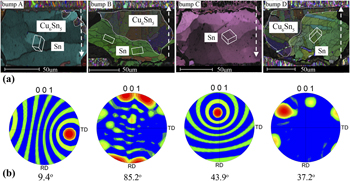Crossref Citations
This article has been cited by the following publications. This list is generated based on data provided by
Crossref.
Lee, Kiju
Kim, Keun-Soo
Tsukada, Yutaka
Suganuma, Katsuaki
Yamanaka, Kimihiro
Kuritani, Soichi
and
Ueshima, Minoru
2011.
Influence of crystallographic orientation of Sn–Ag–Cu on electromigration in flip-chip joint.
Microelectronics Reliability,
Vol. 51,
Issue. 12,
p.
2290.
Lee, Kiju
Kim, Keun-Soo
and
Suganuma, Katsuaki
2011.
Influence of indium addition on electromigration behavior of solder joint.
Journal of Materials Research,
Vol. 26,
Issue. 20,
p.
2624.
Kim, Youngseok
Sugahara, Toru
Nagao, Shijo
Suganuma, Katsuaki
Ueshima, Minoru
Albrecht, Hans-Juergen
Wilke, Klaus
and
Strogies, Joerg
2012.
Effects of additional Ni and Co on microstructural evolution in Sn-Ag-Bi-In solder under current stressing.
p.
1.
Wang, Yiwei
Lu, Kuan H.
Gupta, Vikas
Stiborek, Leon
Shirley, Dwayne
Chae, Seung-Hyun
Im, Jay
and
Ho, Paul S.
2012.
Effects of Sn grain structure on the electromigration of Sn–Ag solder joints.
Journal of Materials Research,
Vol. 27,
Issue. 8,
p.
1131.
Lin, Chih-Fan
Lee, Shang-Hua
and
Chen, Chih-Ming
2012.
Effect of Sn Grain Orientation on the Cu6Sn5 Formation in a Sn-Based Solder Under Current Stressing.
Metallurgical and Materials Transactions A,
Vol. 43,
Issue. 8,
p.
2571.
Parks, Gregory
Arfaei, Babak
Benedict, Michael
Cotts, Eric
Lu, Minhua
and
Perfecto, Eric
2012.
The dependence of the Sn grain structure of Pb-free solder joints on composition and geometry.
p.
703.
Arfaei, B.
Kim, N.
and
Cotts, E.J.
2012.
Dependence of Sn Grain Morphology of Sn-Ag-Cu Solder on Solidification Temperature.
Journal of Electronic Materials,
Vol. 41,
Issue. 2,
p.
362.
Huang, T.C.
Yang, T.L.
Ke, J.H.
Li, C.C.
and
Kao, C.R.
2013.
Precipitation induced by diffusivity anisotropy in Sn grains under electron current stressing.
Journal of Alloys and Compounds,
Vol. 555,
Issue. ,
p.
237.
Parks, Gregory
Faucett, Austin
Fox, Craig
Smith, Jake
and
Cotts, Eric
2014.
The Nucleation of Sn in Undercooled Melts: The Effect of Metal Impurities.
JOM,
Vol. 66,
Issue. 11,
p.
2311.
Hsu, Wei-Neng
and
Ouyang, Fan-Yi
2014.
Effects of anisotropic β-Sn alloys on Cu diffusion under a temperature gradient.
Acta Materialia,
Vol. 81,
Issue. ,
p.
141.
Ji, Hongjun
Wang, Qiang
Li, Mingyu
and
Wang, Chunqing
2014.
Ultrafine-Grain and Isotropic Cu/SAC305/Cu Solder Interconnects Fabricated by High-Intensity Ultrasound-Assisted Solidification.
Journal of Electronic Materials,
Vol. 43,
Issue. 7,
p.
2467.
Parks, Gregory
Lu, Minhua
Perfecto, Eric
and
Cotts, Eric
2014.
Controlling the Sn grain morphology of SnAg C4 solder bumps.
p.
690.
Ma, Limin
Zuo, Yong
Guo, Fu
and
Shu, Yutian
2014.
Effects of current densities on creep behaviors of Sn–3.0Ag–0.5Cu solder joint.
Journal of Materials Research,
Vol. 29,
Issue. 22,
p.
2738.
Huang, T.C.
Yang, T.L.
Ke, J.H.
Hsueh, C.H.
and
Kao, C.R.
2014.
Effects of Sn grain orientation on substrate dissolution and intermetallic precipitation in solder joints under electron current stressing.
Scripta Materialia,
Vol. 80,
Issue. ,
p.
37.
He, Jian-Yang
Lin, Kwang-Lung
and
Wu, Albert T.
2015.
The diminishing of crystal structure of Sn9Zn alloy due to electrical current stressing.
Journal of Alloys and Compounds,
Vol. 619,
Issue. ,
p.
372.
Kim, Min-Young
Chen, Liang-Shan
Chae, Seung-Hyun
and
Kim, Choong-Un
2015.
Mechanism of void formation in Cu post solder joint under electromigration.
p.
135.
An, Rong
Tian, Yanhong
Zhang, Rui
and
Wang, Chunqing
2015.
Electromigration-induced intermetallic growth and voids formation in symmetrical Cu/Sn/Cu and Cu/Intermetallic compounds (IMCs)/Cu joints.
Journal of Materials Science: Materials in Electronics,
Vol. 26,
Issue. 5,
p.
2674.
Huang, M.L.
Zhao, J.F.
Zhang, Z.J.
and
Zhao, N.
2015.
Role of diffusion anisotropy in β-Sn in microstructural evolution of Sn-3.0Ag-0.5Cu flip chip bumps undergoing electromigration.
Acta Materialia,
Vol. 100,
Issue. ,
p.
98.
Yamanaka, Kimihiro
Nishikawa, Hiroshi
Taguchi, Hirohisa
Harada, Miyuki
and
Ochi, Koichi
2016.
Effect of magnetic flux density on Sn crystallographic orientation in a solder joint system.
Journal of Materials Science: Materials in Electronics,
Vol. 27,
Issue. 4,
p.
3710.
Wei, S.
Ma, H.C.
Chen, J.Q.
and
Guo, J.D.
2016.
Extreme anisotropy of electromigration: Nickel in single-crystal tin.
Journal of Alloys and Compounds,
Vol. 687,
Issue. ,
p.
999.





